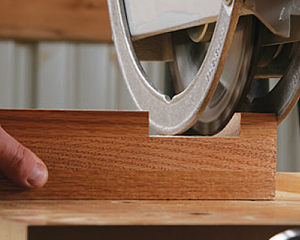
How well and safe would it be to use a dado blade set up on a radial arm saw? I would like any information on this subject, about if it will work, and the safety aspects as well. Keep up the good work, I love y’all’s magazine. – Jeff Dees
Tim Inman: Safe to dado? NO! NOT SAFE AT ALL. In my opinion, a radial arm saw is just about one of the most dangerous saws out there. Other than for cutting rafters on a jobsite, I’m not a fan of the once-popular radial arm saw, so bear that in mind as you read my answer. All the radial arm saws I’ve ever used had the blade rotating so that it cut in what machinists would call a ‘”climb” cut. In other words, the saw teeth spin in a direction pulling the wood back into the fence behind it, and pushing the blade out across the board — the blade wants to literally climb or walk out (run out!) on top of the board. You don’t have to pull the blade into the cut once it gets started with a radial arm saw; it will push itself out into the cut. The operator actually has to push back a little to keep the blade from coming on too fast. So, add the dado set, and now you have some real force wanting to plow out and run across the board. This is a disaster just waiting to happen. Rip cutting on a radial arm saw is something that should be locked out, too. One of my college professors had a demonstration he loved to show young students. He would literally shoot a board out the back side of a radial arm saw during the ripping process by allowing the saw — and a loose arm — to climb up and get a good grab on the board before launching it like a missile. This was the equivalent of a table saw kickback, but with more power and more drama. Exact same physical phenomenon. So, no, don’t try dado cuts on a radial arm saw. Actually, I’d be happier if you got rid of that saw while you still have arms and fingers to use to read these articles. I’m really against radial arm saws …
Chris Marshall: It’s possible to use a dado blade on a radial arm saw — but I say this with a huge caveat: as you probably know, radial arm saws need to be operated with utmost caution. Because the blade rotates with the direction of of the pull cut instead of against it, there is the potential danger of the blade climbing up over the workpiece toward the operator if you pull the saw carriage through the cut too quickly. This can happen either with a standard blade or a dado blade. And when the saw wants to “get up and go” this way, it is frightening! My advice is this: if you must use a radial arm saw for dadoing, cut them in several light passes of increasing depth instead of a deep hogging pass. And, use a narrow cutting width (just a few chipper blades and the two outer blades). It will reduce the stress on the saw and make the cutting process a bit safer. Always stand clear of the blade’s cutting path, and wear a short-sleeved shirt or roll your sleeves up as far as they will go. Follow the guidelines outlined in your radial arm saw’s owner’s manual for dado blade installation and operation, and by all means, keep your full attention on what you are doing here. If you don’t feel comfortable with the technique, make those dado cuts with a router and straight bit or on a table saw instead. If I were given these three options for dadoing, the radial arm saw would far and above be my last choice.





